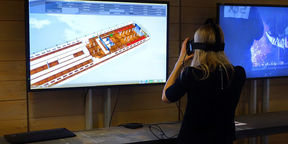Game Design Meets Cruise Ship Design

Reina Magica met Markus Ahola, the programme director of the Cruise and Ferry Program while sailing from Portugal to Brasil on a student organised learning experience called Aalto on Waves. This serendipitous encounter inspired Magica to begin a game-design based cruise project under Ahola's supervision in 2013. During the project, she also consulted with the Aalto Built Environment Lab team, while Felipe Marjalizo Alonso was employed for the project to assist her with program design and coding work.
In her thesis, Magica starts by comparing game and cruise ship design. Magica points out that both games and cruises aim to evoke unique, fantasy-like experiences. However, the design conventions are very different in the respective fields. Magica proposes that by incorporating methods and ideas from game design, the traditionally slow and expensive process of cruise ship interior design could become faster and more cost-effective.
Cruise ship design involves designing entertaining and pleasant experiences. Consequently, it is important to be able to evaluate the user reaction to the proposed designs. On this account, life-size models of the most critical and important spaces of a cruise ship are built in the shipyard to test the feel of the spaces in real scale. Then again, borrowing from game design, such user tests could be run using 3D graphics and virtual reality (VR). With VR and the upcoming wave of consumer VR devices, the real-scale immersive experience can be emulated more quickly and more cost-effectively.
Another useful aspect from games is that an immersive situation can motivate the player to act as in real life. Part of the immersion is achieved through the use of virtual reality and the other part by emulating the social interactions possible on board. These could include interactions with the crew members and other passengers. Especially this aspect is missing from most pre-production user testing of cruise ship interior designs. All in all, it is easier for a player of a game to be immersed in a mission than a test user in a test task.
Using a 3D virtual model also enables testing many ideas during a single session. The Proteus tool allows the implementation of instant changes to the virtual environment in real time. The designers have an opportunity to play around with colours and materials, and test users and stakeholders in the cruise venture may give rapid feedback towards the visual design elements of the cruise. The system also tracks the actions of the player/test user automatically for future analysis. This data collection method can be used together with more traditional methods, such as interviews and questionnaires.
Moreover, cruise ship design could borrow from game design's rapid-prototyping process. Magica used this approach in her own thesis, where she developed a playable prototype quickly with the most central features in a short period of time, and it was continuously modified since its conception.
Magica’s work was presented as one of the results of FIMECC (Finnish Strategic Centre for Science,Technology and Innovation) at SHOK summit in May 2014. The team also authored a paper based on Magica’s thesis for RINA conference (The Royal Institution of Naval Architects), which was presented in Busan, Korea in 2013. The paper discussed the Proteus tool and elaborated on how to utilise game design to improve ship design processes.






